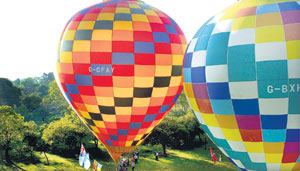
Off you go and where you’ll land you never knowStanding in the middle of a field in Dambulla, Captain Anil Jayasinghe releases a bright blue helium balloon. He watches it with surprising concentration as it goes straight up, drifting first this way, then that. We have got up at 4:30 a.m to be here on this crisp, clear morning, and as Captain Jayasinghe tracks the balloon’s progress, everyone is glad to know that today, conditions are good enough to allow for ballooning. Around his tall figure, teams of balloonists participating in the third Sri Lanka Hot Air Balloon Festival have already swung into action, and are in the process of unloading, unrolling, testing and finally inflating their balloons.
Hot air balloonists share a strange and demanding passion. In a world of dazzling modern technology, where speed is everything, they are content to sweat, and swear and labour to participate in a sport that is still unabashedly romantic. Like the naval captains of yore, theirs is a world where human skill is paramount, reveals Captain Jayasinghe. Here, team work, experience, knowledge and adaptability count for a great deal, as does a certain amount of undiluted adventurousness. For all their simplicity, the balloons that Captain Jayasinghe and his friends fly are a modern marvel. The envelopes are made of a fabric called ripstop that resists tears, and is coated with thermally enduring material. An envelope can contain anything from 30,000 cubic feet to 425,000 cubic feet of air, and the largest can carry 20 people or more. They qualify as lighter than air aircraft and come equipped with a basic GPS, a normal communication set, a fire extinguisher and something which can be used to ignite the burner in a case of emergency, says Captain Jayasinghe. For him, as for the other pilots safety is of paramount importance and everything else – the time they stay up and where they land is decided by that. Strictly adhering to such standards are part of what will make it possible for Sri Lanka to host huge ballooning events like the World Balloon Championships. Piloting a hot air balloon in Sri Lanka requires a licence and a good set of eyes. An appreciation of the outdoors, patience, a sense of humour, a willingness to rise before the sun, and a hearty appetite are also pre-requisites, says Captain Jayasinghe. Especially when you consider that Sri Lanka is currently equivalent to the great outback of ballooning. The terrain is remarkably challenging, and a lack of infrastructure in terms of roads, communication and planned power line grids can be daunting. But for all that, it’s worth the effort. Anthony Brown, an English balloonist, used to be a Flight Engineer for the Concorde. “One day I’d be flying at 60,000 feet, at twice the speed of sound, at 1450 miles an hour, (which is faster than a rifle bullet) and then the next day or the next evening, I’m flying in a balloon at five hundred feet, at a walking pace - and having just as much excitement as I did in the Concorde,” he says. Interestingly for him and the others, the pleasure of ballooning is not limited to the actual flight. It’s also one of the best ways to see a country. For all its charm, ballooning remains a niche sport. It can cost 40,000 Sterling Pounds to purchase a new two person balloon. But for balloonists like Jackie O’Connell, it was well worth raiding the housekeeping money. Jackie became a hot air balloon pilot at a time when women weren’t common in the sport. Since then she and her husband Ginger have travelled all over the world. “It’s got to have been 30 years,” she says today, “and we’ve been to some fabulous, fabulous places in the world.” It’s telling that the sport seems to only increase in appeal over time. Audrey and Norman Apsey are attending the Sri Lankan festival for the third time. As an ex-Chairman of the British Balloon and Airship Club (BBAC), Mr. Apsey is well known on the circuit. In this crowd, he’s the “oldest balloonist by a long way,” and after nearly three decades of flying still retains a passion for the sport. Every flight is unique, he says, because “when you take off, you don’t know where you’re going to land.” At 75, he still enjoys the adventure and uncertainty. |
|
||||||
|| Front
Page | News | Editorial | Columns | Sports | Plus | Financial
Times | International | Mirror | TV
Times | Funday
Times || |
| |
Reproduction of articles permitted when used without any alterations to contents and a link to the source page.
|
© Copyright
2008 | Wijeya
Newspapers Ltd.Colombo. Sri Lanka. All Rights Reserved. |
